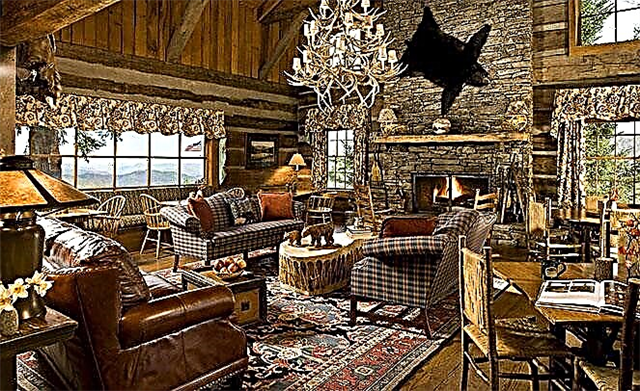Spain's surprisingly warm climate is literally evident in everything: in lifestyle, art, fashion and, of course, in home improvement. And even if you do not know exactly what the inhabitants of this country prefer, buying furniture or household utensils, you can understand that this or that house belongs to the Spaniard. The Spanish style in the interior is an indescribable feeling of warmth and well-being. All design solutions are saturated with these notes. Moreover, even if the decorator is more inclined to modern trends, the small details and finishes in his project will be distinguished by authenticity.

Features of the Spanish style
If you decide to bring Spanish flavor to your interior, you must remember that it has its positive and negative sides. The first include:
- atmosphere of comfort, sun and warmth in the apartment;
- a large amount of light in the room, which is achieved by the features of the layout;
- exquisite and original finishing elements;
- a sense of celebration and serenity that you can share every day with your family and friends.
However, it should be remembered that the decor of such a home will be distinguished by bright colors and richness of shades, so it may happen that a riot of colors and splendor of decoration will soon become familiar to you. Therefore, try to adapt the Spanish style to your taste and preferences as much as possible.
A distinctive feature of the design of residential and office premises in this country is the symbiosis of several architectural styles: Tuscan, Moroccan and French. This makes him relaxed, functional, and unique.
The interiors of Spain are characterized by elegance, simplicity and vibrant colors. They fully convey the national spirit of the Spaniards - their ardor, passion and dedication.
Let's name the main features that make it possible to distinguish the Spanish style from other Mediterranean destinations:
- in the design of windows, ceilings, walls and floors, contrasting shades are used;
- the furniture is chosen massive, with elements of forging;
- the use of exclusively natural materials in the decoration;
- a large number of ornaments and decorative details.
Each aspect of a design project requires detailed consideration.

Finishing features
The design of a Spanish apartment begins with a floor plan. It takes a lot of space to accommodate everything that locals usually place in their living space. And therefore, interior doors are often not used in such a room.
In addition to the usual rectangular shapes, arched structures or elements that have a semicircular shape are installed here. This manifests itself in the form of rounded windows, vaulted ceilings or doorways in the form of arches. These elements are echoes of the Middle Ages and have become entrenched in Spanish design as memories of fortresses, monasteries and Moorish rule.
In the decoration of rooms, the Spaniards prefer to use only natural materials:
- wood;
- sandstone;
- stone;
- ceramic tiles;
- clay.
The walls are most often monochromatic, covered with paint or plaster in combination with the finest glaze of delicate shades, applied to a not entirely smooth surface. The ceiling is usually marked with exposed timber beams or decorative structures.
The floor is also covered with natural wood or ceramic tiles. By the way, stair steps are also decorated with ceramics. It is this feature that makes it possible to distinguish the colonial style of Spain. Floor decoration is related to the purpose of the rooms. For example, in the kitchen, it is customary to use marble, tiles or stone, which are designed to provide coolness on a hot day. The bathroom is finished exclusively with tiles with Moorish ornaments.
The most popular option for decorating windows is shutters or massive wrought iron grilles. In addition, mosaics and stained-glass windows are often used, which are the legacy of the Gothic style in architecture. Moreover, they are used not only in the design of windows - it is customary to decorate with them also interior doors.

Colors in the interior
In the choice of colors, the Spaniards are not too restrained. They prefer rich, juicy tones:
- blue;
- chocolate;
- cherry;
- dark scarlet.
In order to slightly muffle their effect on the eyes and not turn the room into a sultan's palace, they dilute them with calmer shades:
- terracotta;
- pale coral;
- peach;
- pistachio;
- olive;
- pale yellow.
They use milky, white and beige as backgrounds for bright elements. Very often the whole interior is built on the play of contrasts. For example, massive furniture in dark colors in the living room always stands out against the background of light walls.
For the bedroom, muted green and beige are more often used - it is believed that in this room the interior shades should be restrained.

Furniture
Special attention is paid to furnishing items. This is due to the fact that the Spaniards spend a lot of time at home. They love to receive guests or just relax during the heat of the day in the cool, cozy rooms of their home. For this reason, the furniture is always chosen oversized, solid, so that it not only serves for a long time, but also provides maximum comfort.
Preference is given to classic items made from leather or natural wood. Often tables, chairs and cabinets are inlaid with forging or carving.
Furniture is also selected based on exactly where it will stand. For example, a bedroom can be decorated both in a rustic style with a huge dark brown oak bed against a background of white walls, or in a luxuriously sophisticated style: with carved cabinet doors, a huge wrought-iron headboard, elegant bedside tables, a canopy and heavy curtains that protect against sultry sun.
There are three rules in the selection of furniture for the kitchen:
- massiveness;
- coarseness;
- functionality.
Spanish cuisine has many open shelves where you can arrange everything you need to keep it close at hand, rather than having numerous doors open all the time.
Room lighting and the use of textiles
The Spaniards prefer to have as much sunlight as possible in their home. For this reason, the windows in the room are always large. This primarily applies to the kitchen and living room. The latter, even in city apartments, as a rule, has a window opening in the French manner (up to the floor), which allows you to open the sash wide open, covering them with the finest flowing fabric.
As for the sources of artificial light, it is customary to use lamps and lamps with forging elements. They emphasize the style of the interior. The Spaniards choose glass or ceramic lampshades for them.
In the living room you can sometimes see candelabra and massive candlesticks for several candles. And correctly placed mirrors allow not only to enlarge the room in size, but also to enhance the lighting, reflecting lighted candles and lamps.
Not the last place in the design of rooms is occupied by textiles. It creates an atmosphere of comfort, cheers up, disposes to restore strength and energy. For this purpose, the rooms are decorated with numerous homespun rugs, cotton curtains in harmony with the furniture, bright rugs, pillows decorated with ethnic embroidery.
The kitchen is usually distinguished by the presence of capes on the chairs and sturdy bright towels. But in the living room and bedroom on the windows, sets of massive curtains from ceiling to floor with the finest curtains are always used.

Decor and accessories
The main element of the interior of a Spanish house is a fireplace.He is given a key place in the layout of the living room. It serves not only as a source of heat on a cool day (remember that Spain does not have a centralized heating system), but also as a place to sit with a book or with loved ones.
Dishes and décor items made of clay and stone are typical for the Spanish interior.
This is due to the fact that there are more than enough of these two natural components in Spain, unlike wood, which has always been difficult to handle, despite the fact that it is also widely used in interior design.
Bedrooms are always decorated with handmade items:
- embroidered paintings;
- lace napkins;
- carved figurines.
The rooms are literally filled with many figurines, various decorations, paintings in carved frames. And in the kitchen there will always be dishes made of copper and clay, which will be hung on the walls or placed on open shelves, since its purpose is not only to serve for cooking, but also to delight the eyes of the hostess and her guests.
Typical Spanish ornament on faience and ceramics can also be considered an element of decor.

Summarizing
The way we see the interior of a Spanish apartment or house today is largely due to the history of the state, the stay of its territory under the rule of various nationalities. If you want your home to become an island of sunny Spain, the following points should be taken into account in the design project:
- finishing materials should be only natural: wood, stone, marble, clay, ceramic tiles with Moorish ornament;
- the layout of the rooms should be such that the room seems spacious, with a lot of natural light;
- the color palette is selected based on the purpose of the room. For example, it is better to decorate the bedroom in muted colors, bright shades are suitable for the kitchen, but contrast should be adhered to in the design of the living room: dark furniture should stand out against the background of light walls;
- special attention should be paid to the use of ceramic tiles and clay: they are used not only for wall decoration, but also for the manufacture of decorative elements;
- the house must certainly have a fireplace, as well as wrought iron products and homespun textiles.
To equip your home in this style, you need to love Spain very much, know its traditions and national characteristics.











